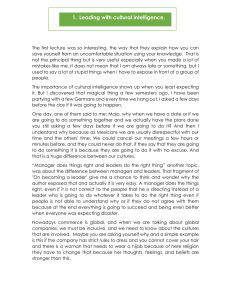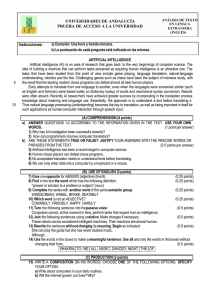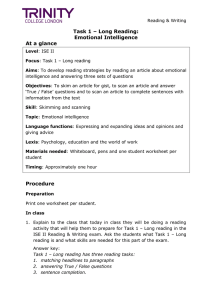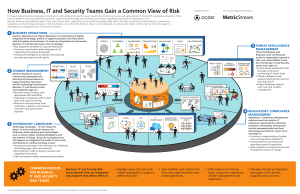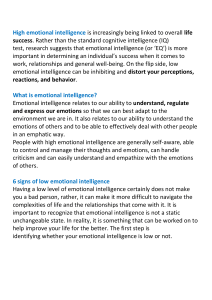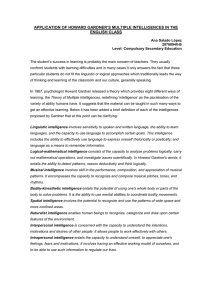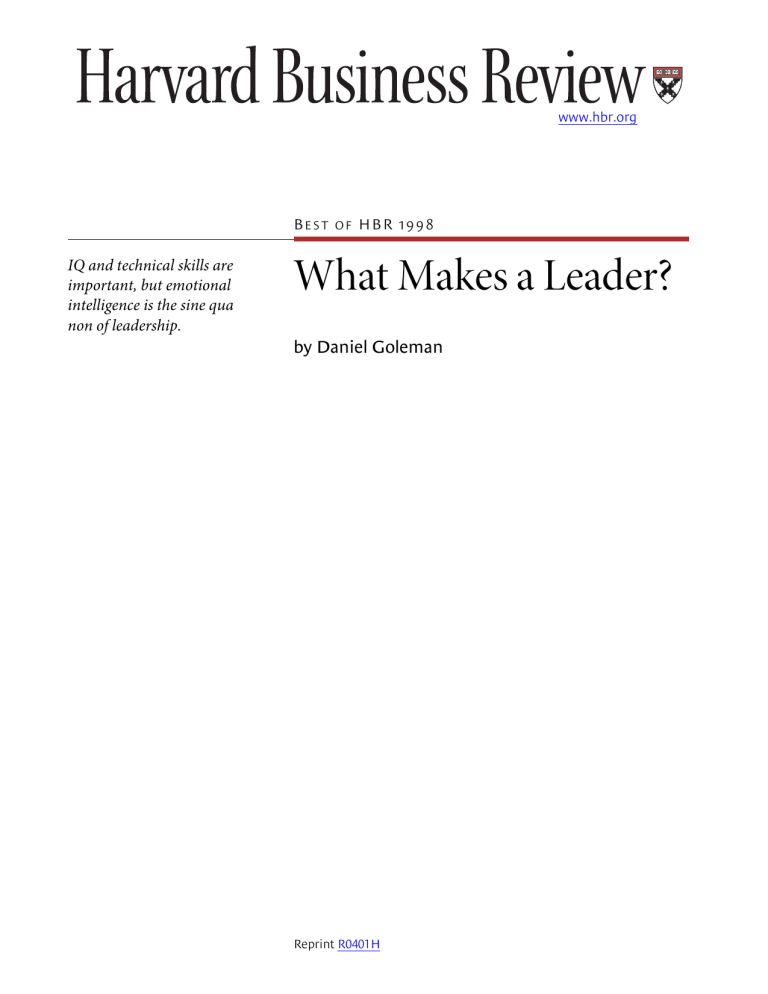
www.hbr.org BEST IQ and technical skills are important, but emotional intelligence is the sine qua non of leadership. OF HBR 1998 What Makes a Leader? by Daniel Goleman Reprint R0401H IQ and technical skills are important, but emotional intelligence is the sine qua non of leadership. BEST OF HBR 1998 What Makes a Leader? by Daniel Goleman COPYRIGHT © 2003 HARVARD BUSINESS SCHOOL PUBLISHING CORPORATION. ALL RIGHTS RESERVED. It was Daniel Goleman who first brought the term “emotional intelligence” to a wide audience with his 1995 book of that name, and it was Goleman who first applied the concept to business with his 1998 HBR article, reprinted here. In his research at nearly 200 large, global companies, Goleman found that while the qualities traditionally associated with leadership—such as intelligence, toughness, determination, and vision—are required for success, they are insufficient. Truly effective leaders are also distinguished by a high degree of emotional intelligence, which includes self-awareness, self-regulation, motivation, empathy, and social skill. These qualities may sound “soft” and unbusinesslike, but Goleman found direct ties between emotional intelligence and measurable business results. While emotional intelligence’s relevance to business has continued to spark debate over the past six years, Goleman’s article remains the definitive reference on the subject, with a description of each component of emotional intelligence and a detailed discussion of how to recognize it in potential leaders, how and why it connects to performance, and how it can be learned. harvard business review • january 2004 Every businessperson knows a story about a highly intelligent, highly skilled executive who was promoted into a leadership position only to fail at the job. And they also know a story about someone with solid—but not extraordinary—intellectual abilities and technical skills who was promoted into a similar position and then soared. Such anecdotes support the widespread belief that identifying individuals with the “right stuff” to be leaders is more art than science. After all, the personal styles of superb leaders vary: Some leaders are subdued and analytical; others shout their manifestos from the mountaintops. And just as important, different situations call for different types of leadership. Most mergers need a sensitive negotiator at the helm, whereas many turnarounds require a more forceful authority. I have found, however, that the most effective leaders are alike in one crucial way: They all have a high degree of what has come to be known as emotional intelligence. It’s not that IQ and technical skills are irrelevant. They do page 1 What Makes a Leader? • B EST OF HBR 1998 matter, but mainly as “threshold capabilities”; that is, they are the entry-level requirements for executive positions. But my research, along with other recent studies, clearly shows that emotional intelligence is the sine qua non of leadership. Without it, a person can have the best training in the world, an incisive, analytical mind, and an endless supply of smart ideas, but he still won’t make a great leader. In the course of the past year, my colleagues and I have focused on how emotional intelligence operates at work. We have examined the relationship between emotional intelligence and effective performance, especially in leaders. And we have observed how emotional intelligence shows itself on the job. How can you tell if someone has high emotional intelligence, for example, and how can you recognize it in yourself? In the following pages, we’ll explore these questions, taking each of the components of emotional intelligence—selfawareness, self-regulation, motivation, empathy, and social skill—in turn. Evaluating Emotional Intelligence Daniel Goleman is the author of Emotional Intelligence (Bantam, 1995) and a coauthor of Primal Leadership: Realizing the Power of Emotional Intelligence (Harvard Business School, 2002). He is the cochairman of the Consortium for Research on Emotional Intelligence in Organizations, which is based at Rutgers University’s Graduate School of Applied and Professional Psychology in Piscataway, New Jersey. He can be reached at [email protected]. harvard business review • january 2004 Most large companies today have employed trained psychologists to develop what are known as “competency models” to aid them in identifying, training, and promoting likely stars in the leadership firmament. The psychologists have also developed such models for lower-level positions. And in recent years, I have analyzed competency models from 188 companies, most of which were large and global and included the likes of Lucent Technologies, British Airways, and Credit Suisse. In carrying out this work, my objective was to determine which personal capabilities drove outstanding performance within these organizations, and to what degree they did so. I grouped capabilities into three categories: purely technical skills like accounting and business planning; cognitive abilities like analytical reasoning; and competencies demonstrating emotional intelligence, such as the ability to work with others and effectiveness in leading change. To create some of the competency models, psychologists asked senior managers at the companies to identify the capabilities that typified the organization’s most outstanding leaders. To create other models, the psychologists used objective criteria, such as a division’s profitability, to differentiate the star perform- ers at senior levels within their organizations from the average ones. Those individuals were then extensively interviewed and tested, and their capabilities were compared. This process resulted in the creation of lists of ingredients for highly effective leaders. The lists ranged in length from seven to 15 items and included such ingredients as initiative and strategic vision. When I analyzed all this data, I found dramatic results. To be sure, intellect was a driver of outstanding performance. Cognitive skills such as big-picture thinking and long-term vision were particularly important. But when I calculated the ratio of technical skills, IQ, and emotional intelligence as ingredients of excellent performance, emotional intelligence proved to be twice as important as the others for jobs at all levels. Moreover, my analysis showed that emotional intelligence played an increasingly important role at the highest levels of the company, where differences in technical skills are of negligible importance. In other words, the higher the rank of a person considered to be a star performer, the more emotional intelligence capabilities showed up as the reason for his or her effectiveness. When I compared star performers with average ones in senior leadership positions, nearly 90% of the difference in their profiles was attributable to emotional intelligence factors rather than cognitive abilities. Other researchers have confirmed that emotional intelligence not only distinguishes outstanding leaders but can also be linked to strong performance. The findings of the late David McClelland, the renowned researcher in human and organizational behavior, are a good example. In a 1996 study of a global food and beverage company, McClelland found that when senior managers had a critical mass of emotional intelligence capabilities, their divisions outperformed yearly earnings goals by 20%. Meanwhile, division leaders without that critical mass underperformed by almost the same amount. McClelland’s findings, interestingly, held as true in the company’s U.S. divisions as in its divisions in Asia and Europe. In short, the numbers are beginning to tell us a persuasive story about the link between a company’s success and the emotional intelligence of its leaders. And just as important, research is also demonstrating that people can, if page 2 What Makes a Leader? • B EST OF HBR 1998 they take the right approach, develop their emotional intelligence. (See the sidebar “Can Emotional Intelligence Be Learned?”) Self-Awareness Self-awareness is the first component of emotional intelligence—which makes sense when one considers that the Delphic oracle gave the advice to “know thyself” thousands of years ago. Self-awareness means having a deep understanding of one’s emotions, strengths, weaknesses, needs, and drives. People with strong self-awareness are neither overly critical nor unrealistically hopeful. Rather, they are honest—with themselves and with others. People who have a high degree of selfawareness recognize how their feelings affect them, other people, and their job performance. Thus, a self-aware person who knows that tight deadlines bring out the worst in him plans his time carefully and gets his work done well in advance. Another person with high selfawareness will be able to work with a demanding client. She will understand the client’s impact on her moods and the deeper reasons for her frustration. “Their trivial demands take us away from the real work that needs to be done,” she might explain. And she will go one step further and turn her anger into something constructive. Self-awareness extends to a person’s understanding of his or her values and goals. Someone who is highly self-aware knows where he is headed and why; so, for example, he will be able to be firm in turning down a job offer that is tempting financially but does not fit with his principles or long-term goals. A person who lacks self-awareness is apt to make decisions that bring on inner turmoil by treading on buried values. “The money looked good so I signed on,” someone might say two years into a job, “but the work means so little to me that I’m constantly bored.” The decisions of selfaware people mesh with their values; consequently, they often find work to be energizing. How can one recognize self-awareness? First and foremost, it shows itself as candor and an ability to assess oneself realistically. People with high self-awareness are able to speak accurately and openly—although not necessarily effusively or confessionally— about their emotions and the impact they Self-Awareness Self-Regulation Motivation Empathy Social Skill Definition Hallmarks the ability to recognize and understand your moods, emotions, and drives, as well as their effect on others self-confidence the ability to control or redirect disruptive impulses and moods the propensity to suspend judgment – to think before acting trustworthiness and integrity a passion to work for reasons that go beyond money or status a propensity to pursue goals with energy and persistence strong drive to achieve the ability to understand the emotional makeup of other people skill in treating people according to their emotional reactions expertise in building and retaining talent proficiency in managing relationships and building networks an ability to find common ground and build rapport effectiveness in leading change harvard business review • january 2004 realistic self-assessment self-deprecating sense of humor comfort with ambiguity openness to change optimism, even in the face of failure organizational commitment cross-cultural sensitivity service to clients and customers persuasiveness expertise in building and leading teams Copyright © 2003 Harvard Business School Publishing Corporation. All rights reserved. The Five Components of Emotional Intelligence at Work page 3 What Makes a Leader? • B EST OF HBR 1998 Can Emotional Intelligence Be Learned? For ages, people have debated if leaders are born or made. So too goes the debate about emotional intelligence. Are people born with certain levels of empathy, for example, or do they acquire empathy as a result of life’s experiences? The answer is both. Scientific inquiry strongly suggests that there is a genetic component to emotional intelligence. Psychological and developmental research indicates that nurture plays a role as well. How much of each perhaps will never be known, but research and practice clearly demonstrate that emotional intelligence can be learned. One thing is certain: Emotional intelligence increases with age. There is an old-fashioned word for the phenomenon: maturity. Yet even with maturity, some people still need training to enhance their emotional intelligence. Unfortunately, far too many training programs that intend to build leadership skills—including emotional intelligence—are a waste of time and money. The problem is simple: They focus on the wrong part of the brain. Emotional intelligence is born largely in the neurotransmitters of the brain’s limbic system, which governs feelings, impulses, and drives. Research indicates that the limbic system learns best through motivation, extended practice, and feedback. Compare this with the kind of learning that goes on in the neocortex, which governs analytical and technical ability. The neocortex grasps concepts and logic. It is the part of the brain that figures out how to use a computer or make a sales call by reading a book. Not surprisingly—but mistakenly—it is also the part of the brain targeted by most training programs aimed at enhancing emotional intelligence. When such programs take, in effect, a neocortical approach, my research with harvard business review • january 2004 the Consortium for Research on Emotional Intelligence in Organizations has shown they can even have a negative impact on people’s job performance. To enhance emotional intelligence, organizations must refocus their training to include the limbic system. They must help people break old behavioral habits and establish new ones. That not only takes much more time than conventional training programs, it also requires an individualized approach. Imagine an executive who is thought to be low on empathy by her colleagues. Part of that deficit shows itself as an inability to listen; she interrupts people and doesn’t pay close attention to what they’re saying. To fix the problem, the executive needs to be motivated to change, and then she needs practice and feedback from others in the company. A colleague or coach could be tapped to let the executive know when she has been observed failing to listen. She would then have to replay the incident and give a better response; that is, demonstrate her ability to absorb what others are saying. And the executive could be directed to observe certain executives who listen well and to mimic their behavior. With persistence and practice, such a process can lead to lasting results. I know one Wall Street executive who sought to improve his empathy—specifically his ability to read people’s reactions and see their perspectives. Before beginning his quest, the executive’s subordinates were terrified of working with him. People even went so far as to hide bad news from him. Naturally, he was shocked when finally confronted with these facts. He went home and told his family—but they only confirmed what he had heard at work. When their opinions on any given subject did not mesh with his, they, too, were frightened of him. Enlisting the help of a coach, the executive went to work to heighten his empathy through practice and feedback. His first step was to take a vacation to a foreign country where he did not speak the language. While there, he monitored his reactions to the unfamiliar and his openness to people who were different from him. When he returned home, humbled by his week abroad, the executive asked his coach to shadow him for parts of the day, several times a week, to critique how he treated people with new or different perspectives. At the same time, he consciously used on-the-job interactions as opportunities to practice “hearing” ideas that differed from his. Finally, the executive had himself videotaped in meetings and asked those who worked for and with him to critique his ability to acknowledge and understand the feelings of others. It took several months, but the executive’s emotional intelligence did ultimately rise, and the improvement was reflected in his overall performance on the job. It’s important to emphasize that building one’s emotional intelligence cannot—will not—happen without sincere desire and concerted effort. A brief seminar won’t help; nor can one buy a how-to manual. It is much harder to learn to empathize—to internalize empathy as a natural response to people—than it is to become adept at regression analysis. But it can be done. “Nothing great was ever achieved without enthusiasm,” wrote Ralph Waldo Emerson. If your goal is to become a real leader, these words can serve as a guidepost in your efforts to develop high emotional intelligence. page 4 What Makes a Leader? • B EST OF HBR 1998 have on their work. For instance, one manager I know of was skeptical about a new personal-shopper service that her company, a major department-store chain, was about to introduce. Without prompting from her team or her boss, she offered them an explanation: “It’s hard for me to get behind the rollout of this service,” she admitted, “because I really wanted to run the project, but I wasn’t selected. Bear with me while I deal with that.” The manager did indeed examine her feelings; a week later, she was supporting the project fully. Such self-knowledge often shows itself in the hiring process. Ask a candidate to describe a time he got carried away by his feelings and did something he later regretted. Self-aware candidates will be frank in admitting to failure—and will often tell their tales with a smile. One of the hallmarks of self-awareness is a selfdeprecating sense of humor. Self-awareness can also be identified during performance reviews. Self-aware people know—and are comfortable talking about— their limitations and strengths, and they often demonstrate a thirst for constructive criticism. By contrast, people with low self-awareness interpret the message that they need to improve as a threat or a sign of failure. Self-aware people can also be recognized by their self-confidence. They have a firm grasp of their capabilities and are less likely to set themselves up to fail by, for example, overstretching on assignments. They know, too, when to ask for help. And the risks they take on the job are calculated. They won’t ask for a challenge that they know they can’t handle alone. They’ll play to their strengths. Consider the actions of a midlevel employee who was invited to sit in on a strategy meeting with her company’s top executives. Although she was the most junior person in the room, she did not sit there quietly, listening in awestruck or fearful silence. She knew she had a head for clear logic and the skill to present ideas persuasively, and she offered cogent suggestions about the company’s strategy. At the same time, her self-awareness stopped her from wandering into territory where she knew she was weak. Despite the value of having self-aware people in the workplace, my research indicates that senior executives don’t often give selfawareness the credit it deserves when they harvard business review • january 2004 look for potential leaders. Many executives mistake candor about feelings for “wimpiness” and fail to give due respect to employees who openly acknowledge their shortcomings. Such people are too readily dismissed as “not tough enough” to lead others. In fact, the opposite is true. In the first place, people generally admire and respect candor. Furthermore, leaders are constantly required to make judgment calls that require a candid assessment of capabilities—their own and those of others. Do we have the management expertise to acquire a competitor? Can we launch a new product within six months? People who assess themselves honestly—that is, self-aware people—are well suited to do the same for the organizations they run. Self-Regulation Biological impulses drive our emotions. We cannot do away with them—but we can do much to manage them. Self-regulation, which is like an ongoing inner conversation, is the component of emotional intelligence that frees us from being prisoners of our feelings. People engaged in such a conversation feel bad moods and emotional impulses just as everyone else does, but they find ways to control them and even to channel them in useful ways. Imagine an executive who has just watched a team of his employees present a botched analysis to the company’s board of directors. In the gloom that follows, the executive might find himself tempted to pound on the table in anger or kick over a chair. He could leap up and scream at the group. Or he might maintain a grim silence, glaring at everyone before stalking off. But if he had a gift for self-regulation, he would choose a different approach. He would pick his words carefully, acknowledging the team’s poor performance without rushing to any hasty judgment. He would then step back to consider the reasons for the failure. Are they personal—a lack of effort? Are there any mitigating factors? What was his role in the debacle? After considering these questions, he would call the team together, lay out the incident’s consequences, and offer his feelings about it. He would then present his analysis of the problem and a well-considered solution. Why does self-regulation matter so much for leaders? First of all, people who are in con- page 5 What Makes a Leader? • B EST OF HBR 1998 trol of their feelings and impulses—that is, people who are reasonable—are able to create an environment of trust and fairness. In such an environment, politics and infighting are sharply reduced and productivity is high. Talented people flock to the organization and aren’t tempted to leave. And self-regulation has a trickle-down effect. No one wants to be known as a hothead when the boss is known for her calm approach. Fewer bad moods at the top mean fewer throughout the organization. Second, self-regulation is important for competitive reasons. Everyone knows that business today is rife with ambiguity and change. Companies merge and break apart regularly. Technology transforms work at a dizzying pace. People who have mastered their emotions are able to roll with the changes. When a new program is announced, they don’t panic; instead, they are able to suspend judgment, seek out information, and listen to the executives as they explain the new program. As the initiative moves forward, these people are able to move with it. Sometimes they even lead the way. Consider the case of a manager at a large manufacturing company. Like her colleagues, she had used a certain software program for five years. The program drove how she collected and reported data and how she thought about the company’s strategy. One day, senior executives announced that a new program was to be installed that would radically change how information was gathered and assessed within the organization. While many people in the company complained bitterly about how disruptive the change would be, the manager mulled over the reasons for the new program and was convinced of its potential to improve performance. She eagerly attended training sessions—some of her colleagues refused to do so—and was eventually promoted to run several divisions, in part because she used the new technology so effectively. I want to push the importance of self-regulation to leadership even further and make the case that it enhances integrity, which is not only a personal virtue but also an organizational strength. Many of the bad things that happen in companies are a function of impulsive behavior. People rarely plan to exaggerate profits, pad expense accounts, dip into the till, or abuse power for selfish ends. Instead, an op- harvard business review • january 2004 portunity presents itself, and people with low impulse control just say yes. By contrast, consider the behavior of the senior executive at a large food company. The executive was scrupulously honest in his negotiations with local distributors. He would routinely lay out his cost structure in detail, thereby giving the distributors a realistic understanding of the company’s pricing. This approach meant the executive couldn’t always drive a hard bargain. Now, on occasion, he felt the urge to increase profits by withholding information about the company’s costs. But he challenged that impulse—he saw that it made more sense in the long run to counteract it. His emotional self-regulation paid off in strong, lasting relationships with distributors that benefited the company more than any short-term financial gains would have. The signs of emotional self-regulation, therefore, are easy to see: a propensity for reflection and thoughtfulness; comfort with ambiguity and change; and integrity—an ability to say no to impulsive urges. Like self-awareness, self-regulation often does not get its due. People who can master their emotions are sometimes seen as cold fish—their considered responses are taken as a lack of passion. People with fiery temperaments are frequently thought of as “classic” leaders—their outbursts are considered hallmarks of charisma and power. But when such people make it to the top, their impulsiveness often works against them. In my research, extreme displays of negative emotion have never emerged as a driver of good leadership. Motivation If there is one trait that virtually all effective leaders have, it is motivation. They are driven to achieve beyond expectations—their own and everyone else’s. The key word here is achieve. Plenty of people are motivated by external factors, such as a big salary or the status that comes from having an impressive title or being part of a prestigious company. By contrast, those with leadership potential are motivated by a deeply embedded desire to achieve for the sake of achievement. If you are looking for leaders, how can you identify people who are motivated by the drive to achieve rather than by external rewards? The first sign is a passion for the work itself— such people seek out creative challenges, love page 6 What Makes a Leader? • B EST OF HBR 1998 to learn, and take great pride in a job well done. They also display an unflagging energy to do things better. People with such energy often seem restless with the status quo. They are persistent with their questions about why things are done one way rather than another; they are eager to explore new approaches to their work. A cosmetics company manager, for example, was frustrated that he had to wait two weeks to get sales results from people in the field. He finally tracked down an automated phone system that would beep each of his salespeople at 5 pm every day. An automated message then prompted them to punch in their numbers—how many calls and sales they had made that day. The system shortened the feedback time on sales results from weeks to hours. That story illustrates two other common traits of people who are driven to achieve. They are forever raising the performance bar, and they like to keep score. Take the performance bar first. During performance reviews, people with high levels of motivation might ask to be “stretched” by their superiors. Of course, an employee who combines self-awareness with internal motivation will recognize her limits—but she won’t settle for objectives that seem too easy to fulfill. And it follows naturally that people who are driven to do better also want a way of tracking progress—their own, their team’s, and their company’s. Whereas people with low achievement motivation are often fuzzy about results, those with high achievement motivation often keep score by tracking such hard measures as profitability or market share. I know of a money manager who starts and ends his day on the Internet, gauging the performance of his stock fund against four industry-set benchmarks. Interestingly, people with high motivation remain optimistic even when the score is against them. In such cases, self-regulation combines with achievement motivation to overcome the frustration and depression that come after a setback or failure. Take the case of an another portfolio manager at a large investment company. After several successful years, her fund tumbled for three consecutive quarters, leading three large institutional clients to shift their business elsewhere. Some executives would have blamed the harvard business review • january 2004 nosedive on circumstances outside their control; others might have seen the setback as evidence of personal failure. This portfolio manager, however, saw an opportunity to prove she could lead a turnaround. Two years later, when she was promoted to a very senior level in the company, she described the experience as “the best thing that ever happened to me; I learned so much from it.” Executives trying to recognize high levels of achievement motivation in their people can look for one last piece of evidence: commitment to the organization. When people love their jobs for the work itself, they often feel committed to the organizations that make that work possible. Committed employees are likely to stay with an organization even when they are pursued by headhunters waving money. It’s not difficult to understand how and why a motivation to achieve translates into strong leadership. If you set the performance bar high for yourself, you will do the same for the organization when you are in a position to do so. Likewise, a drive to surpass goals and an interest in keeping score can be contagious. Leaders with these traits can often build a team of managers around them with the same traits. And of course, optimism and organizational commitment are fundamental to leadership— just try to imagine running a company without them. Empathy Of all the dimensions of emotional intelligence, empathy is the most easily recognized. We have all felt the empathy of a sensitive teacher or friend; we have all been struck by its absence in an unfeeling coach or boss. But when it comes to business, we rarely hear people praised, let alone rewarded, for their empathy. The very word seems unbusinesslike, out of place amid the tough realities of the marketplace. But empathy doesn’t mean a kind of “I’m OK, you’re OK” mushiness. For a leader, that is, it doesn’t mean adopting other people’s emotions as one’s own and trying to please everybody. That would be a nightmare—it would make action impossible. Rather, empathy means thoughtfully considering employees’ feelings—along with other factors—in the process of making intelligent decisions. For an example of empathy in action, con- page 7 What Makes a Leader? • B EST OF HBR 1998 sider what happened when two giant brokerage companies merged, creating redundant jobs in all their divisions. One division manager called his people together and gave a gloomy speech that emphasized the number of people who would soon be fired. The manager of another division gave his people a different kind of speech. He was up-front about his own worry and confusion, and he promised to keep people informed and to treat everyone fairly. The difference between these two managers was empathy. The first manager was too worried about his own fate to consider the feelings of his anxiety-stricken colleagues. The second knew intuitively what his people were feeling, and he acknowledged their fears with his words. Is it any surprise that the first manager saw his division sink as many demoralized people, especially the most talented, departed? By contrast, the second manager continued to be a strong leader, his best people stayed, and his division remained as productive as ever. Empathy is particularly important today as a component of leadership for at least three reasons: the increasing use of teams; the rapid pace of globalization; and the growing need to retain talent. Consider the challenge of leading a team. As anyone who has ever been a part of one can attest, teams are cauldrons of bubbling emotions. They are often charged with reaching a consensus—which is hard enough with two people and much more difficult as the numbers increase. Even in groups with as few as four or five members, alliances form and clashing agendas get set. A team’s leader must be able to sense and understand the viewpoints of everyone around the table. That’s exactly what a marketing manager at a large information technology company was able to do when she was appointed to lead a troubled team. The group was in turmoil, overloaded by work and missing deadlines. Tensions were high among the members. Tinkering with procedures was not enough to bring the group together and make it an effective part of the company. So the manager took several steps. In a series of one-on-one sessions, she took the time to listen to everyone in the group—what was frustrating them, how they rated their colleagues, whether they felt they had been ignored. And then she directed the team in a way that brought it together: She encouraged harvard business review • january 2004 people to speak more openly about their frustrations, and she helped people raise constructive complaints during meetings. In short, her empathy allowed her to understand her team’s emotional makeup. The result was not just heightened collaboration among members but also added business, as the team was called on for help by a wider range of internal clients. Globalization is another reason for the rising importance of empathy for business leaders. Cross-cultural dialogue can easily lead to miscues and misunderstandings. Empathy is an antidote. People who have it are attuned to subtleties in body language; they can hear the message beneath the words being spoken. Beyond that, they have a deep understanding of both the existence and the importance of cultural and ethnic differences. Consider the case of an American consultant whose team had just pitched a project to a potential Japanese client. In its dealings with Americans, the team was accustomed to being bombarded with questions after such a proposal, but this time it was greeted with a long silence. Other members of the team, taking the silence as disapproval, were ready to pack and leave. The lead consultant gestured them to stop. Although he was not particularly familiar with Japanese culture, he read the client’s face and posture and sensed not rejection but interest—even deep consideration. He was right: When the client finally spoke, it was to give the consulting firm the job. Finally, empathy plays a key role in the retention of talent, particularly in today’s information economy. Leaders have always needed empathy to develop and keep good people, but today the stakes are higher. When good people leave, they take the company’s knowledge with them. That’s where coaching and mentoring come in. It has repeatedly been shown that coaching and mentoring pay off not just in better performance but also in increased job satisfaction and decreased turnover. But what makes coaching and mentoring work best is the nature of the relationship. Outstanding coaches and mentors get inside the heads of the people they are helping. They sense how to give effective feedback. They know when to push for better performance and when to hold back. In the way they motivate their protégés, they demonstrate empathy in action. In what is probably sounding like a refrain, page 8 What Makes a Leader? • B EST OF HBR 1998 let me repeat that empathy doesn’t get much respect in business. People wonder how leaders can make hard decisions if they are “feeling” for all the people who will be affected. But leaders with empathy do more than sympathize with people around them: They use their knowledge to improve their companies in subtle but important ways. Social Skill The first three components of emotional intelligence are self-management skills. The last two, empathy and social skill, concern a person’s ability to manage relationships with others. As a component of emotional intelligence, social skill is not as simple as it sounds. It’s not just a matter of friendliness, although people with high levels of social skill are rarely meanspirited. Social skill, rather, is friendliness with a purpose: moving people in the direction you desire, whether that’s agreement on a new marketing strategy or enthusiasm about a new product. Socially skilled people tend to have a wide circle of acquaintances, and they have a knack for finding common ground with people of all kinds—a knack for building rapport. That doesn’t mean they socialize continually; it means they work according to the assumption that nothing important gets done alone. Such people have a network in place when the time for action comes. Social skill is the culmination of the other dimensions of emotional intelligence. People tend to be very effective at managing relationships when they can understand and control their own emotions and can empathize with the feelings of others. Even motivation contributes to social skill. Remember that people who are driven to achieve tend to be optimistic, even in the face of setbacks or failure. When people are upbeat, their “glow” is cast upon conversations and other social encounters. They are popular, and for good reason. Because it is the outcome of the other dimensions of emotional intelligence, social skill is recognizable on the job in many ways that will by now sound familiar. Socially skilled people, for instance, are adept at managing teams—that’s their empathy at work. Likewise, they are expert persuaders—a manifestation of self-awareness, self-regulation, and empathy combined. Given those skills, good persuaders know when to make an emotional harvard business review • january 2004 plea, for instance, and when an appeal to reason will work better. And motivation, when publicly visible, makes such people excellent collaborators; their passion for the work spreads to others, and they are driven to find solutions. But sometimes social skill shows itself in ways the other emotional intelligence components do not. For instance, socially skilled people may at times appear not to be working while at work. They seem to be idly schmoozing—chatting in the hallways with colleagues or joking around with people who are not even connected to their “real” jobs. Socially skilled people, however, don’t think it makes sense to arbitrarily limit the scope of their relationships. They build bonds widely because they know that in these fluid times, they may need help someday from people they are just getting to know today. For example, consider the case of an executive in the strategy department of a global computer manufacturer. By 1993, he was convinced that the company’s future lay with the Internet. Over the course of the next year, he found kindred spirits and used his social skill to stitch together a virtual community that cut across levels, divisions, and nations. He then used this de facto team to put up a corporate Web site, among the first by a major company. And, on his own initiative, with no budget or formal status, he signed up the company to participate in an annual Internet industry convention. Calling on his allies and persuading various divisions to donate funds, he recruited more than 50 people from a dozen different units to represent the company at the convention. Management took notice: Within a year of the conference, the executive’s team formed the basis for the company’s first Internet division, and he was formally put in charge of it. To get there, the executive had ignored conventional boundaries, forging and maintaining connections with people in every corner of the organization. Is social skill considered a key leadership capability in most companies? The answer is yes, especially when compared with the other components of emotional intelligence. People seem to know intuitively that leaders need to manage relationships effectively; no leader is an island. After all, the leader’s task is to get work done through other people, and social page 9 What Makes a Leader? • B EST OF HBR 1998 skill makes that possible. A leader who cannot express her empathy may as well not have it at all. And a leader’s motivation will be useless if he cannot communicate his passion to the organization. Social skill allows leaders to put their emotional intelligence to work. It would be foolish to assert that good-oldfashioned IQ and technical ability are not important ingredients in strong leadership. But the recipe would not be complete without emotional intelligence. It was once thought that the components of emotional intelligence were “nice to have” in business leaders. But now we know that, for the sake of performance, these are ingredients that leaders harvard business review • january 2004 “need to have.” It is fortunate, then, that emotional intelligence can be learned. The process is not easy. It takes time and, most of all, commitment. But the benefits that come from having a welldeveloped emotional intelligence, both for the individual and for the organization, make it worth the effort. Reprint R0401H; Harvard Business Review OnPoint 3790 To order, see the next page or call 800-988-0886 or 617-783-7500 or go to www.hbr.org page 10 Further Reading Harvard Business Review OnPoint articles enhance the full-text article with a summary of its key points and a selection of its company examples to help you quickly absorb and apply the concepts. Harvard Business Review OnPoint collections include three OnPoint articles and an overview comparing the various perspectives on a specific topic. What Makes a Leader? is also part of the Harvard Business Review OnPoint collection Best of HBR on Leadership: Emotionally Intelligent Leadership, Product no. 8156, which includes these additional articles: Primal Leadership: The Hidden Driver of Great Performance Daniel Goleman, Richard Boyatzis, and Annie McKee Harvard Business Review December 2001 Product no. 8296 Leadership That Gets Results Daniel Goleman Harvard Business Review July–August 2000 Product no. 4487 To Order For reprints, Harvard Business Review OnPoint orders, and subscriptions to Harvard Business Review: Call 800-988-0886 or 617-783-7500. Go to www.hbr.org For customized and quantity orders of reprints and Harvard Business Review OnPoint products: Call Frank Tamoshunas at 617-783-7626, or e-mail him at [email protected] page 11

